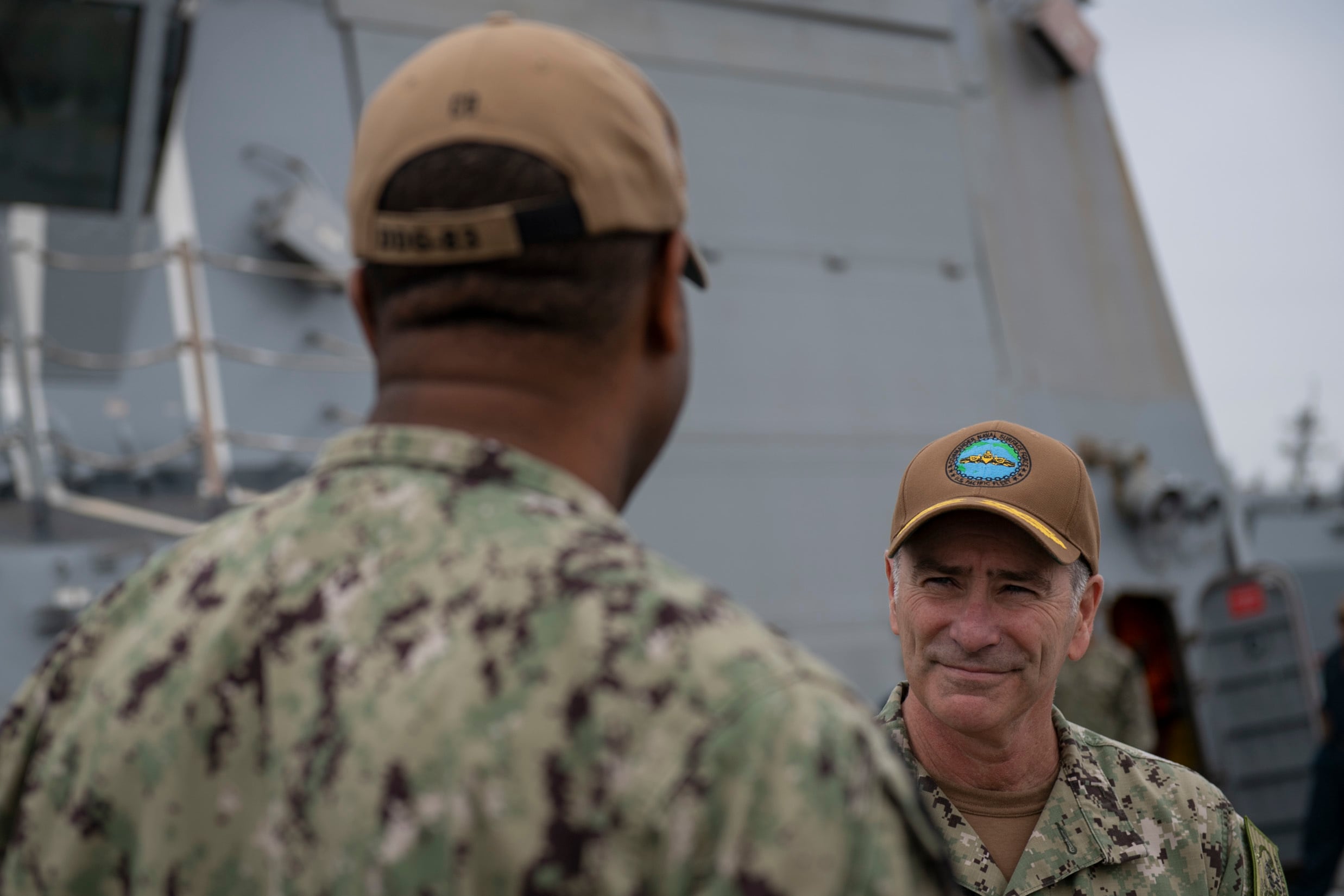As the U.S. Navy tries to boost the warfighting performance of all its units, the surface force is looking at diversity and leadership as ways to get after that.
Commander of Naval Surface Forces Vice Adm. Roy Kitchener said the surface force is the most diverse of all the Navy’s major warfare areas, but he’s not satisfied and thinks that focusing on diversity and inclusion can help the force gain further advantage over potential adversaries in multiple ways.
“Our adversaries think differently than we do,” Kitchener told Navy Times April 7 after speaking at the first-ever Surface Force Diversity, Equity and Inclusion Symposium in Norfolk, Virginia. “We have a lot of people in our country with a very diverse thought process, and that is a real strength when you’re teaching people tactics.
“When people can say, okay, what do you think the opponent is going to do? … Your opponent is not necessarily thinking like you, and what I found is that, if you can have people on our team that can think out of the box, perhaps different than the conventional Western way to think, it really is a game changer.”
More broadly, he added, “it’s a proven fact that the more diverse you are, you’re going to be a better and more high-performing organization. But I just see it simply from the warfare perspective, where being able to have a team that can think with that kind of agility against an opponent that probably doesn’t have that agility is a huge advantage.”
Rear Adm. Brendan McLane, the commander of Naval Surface Force Atlantic, offered up the Ukrainian military and territorial defense forces’ recent performance as an example of the need for agile thinking.
During the same interview, he cited an old Navy saying: “People matter more than guns in the rating of a ship.”
“I think if we look at what’s happening in Ukraine right now, we can definitely see it’s the people that are making the difference, not the warfighting equipment. … The way they are fighting — the thoughts that are going into asymmetrically battling a much superior force and winning — I think that really shows you the difference people can make in combat.”
Kitchener and McLane said several factors are at play when looking at how to increase the performance of the surface fleet. As they aim to eliminate gaps in at-sea billets, boosting retention is one key to solving the problem. Sailors tend to stay in the service when they are happy with their jobs and working in high-performing units, meaning the Navy needs to do whatever it can to keep top performers around to serve as tomorrow’s leaders. In some cases, that means building an inclusive environment where all sailors can feel welcome, as well as perhaps giving some sailors additional mentoring or training so they can achieve their full potential and help create a diverse leadership team down the line.
“Our people are our critical strength, and that’s going to make the difference for us in the strategic competition that we’re in,” McLane said during the call. “And having the greatest amount of talent available on our ships and in our fleet is going to be the difference.”
Diversity in new recruits hasn’t changed much in recent years, and the percentage of women joining the force has increased at about half a percentage point a year, meaning retention is where the Navy can make the biggest change. Kitchener said that today about 32.5% of the surface community comes from diverse backgrounds, and 23.2% of the surface force are women, putting the force particularly out of line with the general population when it comes to gender.
About 350 attended the two-day symposium, McLane noted. “There’s a real hunger to talk about the issues and a real hunger to plug in and be part of the solution, too,” he said.

Kitchener said the surface fleet has conducted a junior officer training symposium focused on diversity and that several recent surveys of officers at different ranks had pointed to some areas where surface force leadership could make the community more attractive to join and stay in.
In keeping with his drive to address challenges in a data-driven way, Kitchener also said he’d kick off a Leadership Assessment Program pilot this spring to determine how to best develop the right kinds of leaders to serve at sea and lead diverse teams.
The pilot program, which will start in May, will focus on leadership and character development, assess which traits are most needed in leader development, and will help Kitchener and his team figure out the best places to start to implement future leadership and character development initiatives.
Kitchener couched the effort within the context of larger reforms in the surface force over the past five years: The community had bolstered its maritime skills training — seamanship, navigation and ship handling — in the immediate aftermath of several collisions and groundings in 2017. The community is now well into improving its tactical training, preparing the force for an increasingly complex operating environment in places like the South China Sea.
Now, the three-star admiral said, the community needs to turn its focus to character. The pilot program will help him and his team determine the best way to move forward in assessing and building the right character traits for surface sailors and leaders.
McLane told Navy Times that he hoped the symposium would be the start of a broader conversation and would send surface warfare sailors back to their commands with some homework that would continue pushing the issue forward.
Among the first taskers he jotted down during the event, he said, was asking ship commanding officers to consider their role in growing talent from within their crews, retaining that talent, and ensuring that talent reflects the diversity of the country.
“Retaining the very best people that we have and promoting them, that I think is an individual inside-the-lifeline task that each captain has to take on,” McLane said. “And that’s the reason we’re having this conference.
“If we can create an environment on every ship that’s inclusive — which is something I think our millennial sailors expect — and then everybody is treated equally, and then we actually go above and beyond that and actually have equity so everybody’s getting everything that they need to succeed, I think the diversity part is going to take care of itself.
“The talent part is going to take care of itself, but I think that’s just part and parcel of good leadership — of taking care of your sailors.”
Megan Eckstein is the naval warfare reporter at Defense News. She has covered military news since 2009, with a focus on U.S. Navy and Marine Corps operations, acquisition programs and budgets. She has reported from four geographic fleets and is happiest when she’s filing stories from a ship. Megan is a University of Maryland alumna.





